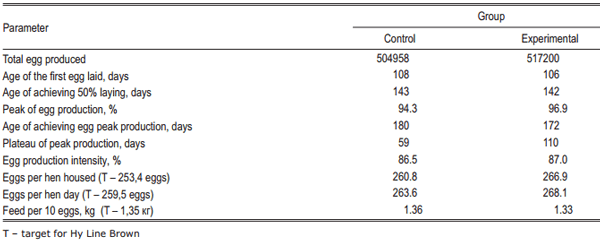The vitagene concept of fighting stresses emerged as a new direction in a nutritional science. Indeed, by improving the adaptive ability of animals to stress it is possible to substantially decrease negative consequences of various stresses in poultry and farm animal production. The aforementioned data clearly showed that the anti-stress composition developed on the vitagene concept is an effective means in fighting stresses in poultry and pig production.
Calabrese V, Cornelius C, Stella AM and Calabrese EJ, 2010. Cellular stress responses, mitostress and carnitine insufficiencies as critical determinants in aging and neurodegenerative disorders: role of hormesis and vitagenes. Neurochemical Research, 35, 1880-1915.
Calabrese V, Calafato S, Puleo E, Cornelius C, Sapienza M Morganti P and Mancuso C, 2008. Redox regulation of cellularstress response by ferulic acid ethyl ester in human dermal fibroblasts: role of vitagenes. Clinics in Dermatology, 26, 358-363.
Chen Z, Xie J, Wang B and Tang J, 2014. Effect of γ-aminobutyricacid on digestive enzymes, absorption function, and immune function of intestinal mucosa in heat-stressed chicken. Poultry Science, 93, 2490-2500.
De Andrade A, Rogler N, Featherson JC and Allison WRCW, 1977. Interrelationships between diet and elevated temperature (cyclic and constant) on egg production and shell quality. Poultry Science 56, 1178-1188.
Dhama K, Chakraborty S, Verma AK, Tiwari R, Barathidasan R, Kumar A and Singh SD, 2013. Fungal/mycotic diseases of poultry-diagnosis, treatment and control: a review. Pakistan Journal of Biological Sciences, 16, 1626-1640.
Dohms JE and Metz A, 1991. Stress mechanisms ofimmunosuppression. Veterinary Immunology and Immuno-pathology, 30, 89-109.
Ebeid TA, Suzuki T and Sugiyama T, 2012. High ambienttemperature influences eggshell quality and calbindin-D28k localization of eggshell gland and all intestinal segments of laying hens. Poultry Science, 91, 2282-2287.
Elibol O, Peak SD and Brake J, 2002. Effect of flock age, length ofegg storage, and frequency of turning during storage on hatchability of broiler hatching eggs. Poultry Science, 81, 945-950.
Fasenko GM, 2007. Egg storage and the embryo. Poultry Science,86, 1020-1024.
Feddes JJR, Emmanuel EJ and Zuidhof MJ,2002. Broilerperformance, body weight variance, feed and water intake, and carcass quality at different stocking densities. Poultry Science 81, 774-779.
Fisinin VI and Surai PF, 2011. Effective protection from stresses inpoultry production: from vitamins to vitagenes. Poultry and Poultry Products (Ptitza and Ptitzeproducti, Russia) 5, 23-26.
Fisinin VI and Surai PF, 2012a. First days of chicken life: from aprotection against stresses to an effective adaptation. Russian Poultry Science (Ptitsevodstvo, Russia), 2, 11-15.
Fisinin VI and Surai PF, 2012b. Properties and toxicity of DON.Mycotoxins and antioxidants: Uncompromising fighting. Part 1. Animal Production of Russia (Zhivotnovodstvo Rossii), 5, 11-14.
Fisinin VI and Surai PF, 2012c. Properties and toxicity of DON.Mycotoxins and antioxidants: Uncompromising fighting. Part 2. Animal Production of Russia (Zhivotnovodstvo Rossii, Russia), 6, 3-5.
Fisinin VI and Surai PF, 2012d. Mycotoxins and antioxidants:Uncompromising fighting. Ochratoxin A. Part 1. Compounded Feed (Kombikorma, Russia), 3, 55-60.
Fisinin VI and Surai PF, 2012e. Mycotoxins and antioxidants:Uncompromising fighting. Ochratoxin A. Part 2. Compounded Feed (Kombikorma, Russia), 5, 59-60.
Fisinin VI and Surai PF, 2012f. Mycotoxins and antioxidants:Uncompromising fighting. T-toxin – metabolism and toxicity. Part 1. Poultry and Poultry Products (Ptiza i Ptizeproducti, Russia), 3, 38-41.
Fisinin VI and Surai PF, 2012g. Mycotoxins and antioxidants: Uncompromising fighting. T-toxin – mechanisms of toxicity and protection. Part 2. Poultry and Poultry Products (Ptiza i Ptizeproducti, Russia), 4, 36-39.
Fisinin VI and Surai PF, 2013a. Immunity in modern animal andpoultry production: from theory to practical aspects of immunomodulation. Russian Poultry Science (Ptitsevodstvo, Russia), 5, 4-10.
Fisinin VI and Surai PF, 2013b. Gut immunity in birds: facts andthinking. Agricultural Biology (Selskokhozaistvennaya Biologia, Russia), 4, 1-25.
Fotina GA, 2011. Effect of water-soluble antistress compositionFeed Food Magic Antistress on the amino acid composition of the layers blood. Proceedings of the XII Ukranian poultry conference with international participation. Kharkov, pp.307-312
Fotina AA, Fotina TI and Surai PF, 2011. Effect of antistresscomposition Feed-Food Magic Antistress Mix on broiler chicks during growth period. Annals of Sumy National Agrarian University, 2, 158-162.
Fotina A, Fotina TI and Surai PF, 2014. Effect of a water-solubleantistress composition on broiler chickens. Proceedings of the. XIVth European Poultry Conference, p.555, June 23-27, Stavanger, Norway.
Fotina AA, Fisinin VI and Surai PF. 2013. Recent developments inusage of natural antioxidants to improve chicken meat production and quality. Bulgarian Journal of Agricultural Science, 19, 889-896.
Franco-Jimenez DJ, Scheideler SE, Kittok RJ, Brown-Brandl TM, Robeson LR, Taira H, and Beck MM, 2007. Differential effectsof heat stress in three strains of laying hens. The Journal of Applied Poultry Research, 16, 628–634.
Fussell LW, 1998. Poultry industry strategies for control ofimmunosuppressive diseases. Poultry Science, 77, 1193-1196.
Gaponov IV, Fotina TI and Surai PF, 2012. Physiological andtechnological stresses at piglet weaning. Protective effect of the antistress composition. , Svinovodstvo Ukrainy (Pig Production in Ukraine), 13, 6-9.
Georgieva NV, Stoyanchev K, Bozakova N and Jotova I, 2011.Combined effects of muscular dystrophy, ecological stress, and selenium on blood antioxidant status in broiler chickens. Biological Trace Element Research, 142, 532-545.
Grobas S, Mendez J, De Blas C and Mateos GG, 1999. Influenceof dietary energy, supplemental fat and linoleic acid concentration on performance of laying hens at two ages. British Poultry Science, 40, 681–687.
Gunnarsson S, Keeling LJ and Svedberg J, 1999, Effect ofrearing factors on the prevalence of floor eggs, cloacal cannibalism and feather pecking in commercial flocks of loose housed laying hens. British Poultry Science, 40, 12-18.
Hayes JD and Dinkova-Kostova AT, 2014. The Nrf2 regulatorynetwork provides an interface between redox and intermediary metabolism. Trends in Biochemical Sciences, 39, 199-218.
Hoerr FJ, 2010. Clinical aspects of immunosuppression in poultry.Avian Diseases, 54, 2-15.
Howden R, 2013. Nrf2 and cardiovascular defense. OxidativeMedicine and Cellular Longevity, 104308. doi: 10.1155/2013/ 104308. Epub 2013 Apr 4.
Ingrao F, Rauw F, Lambrecht B and van den Berg T, 2013. Infectious Bursal Disease: a complex host-pathogen interaction. Developmental and Comparative Immunology, 41, 429-438.
Johnson RW, Curtis SE and Shanks RD, 1991. Effects on chickperformance of ammonia and heat stressors in various combination sequences. Poultry Science 70, 1132-1137.
Karadas F, Surai PF and Sparks NH, 2011. Changes in broilerchick tissue concentrations of lipid-soluble antioxidants immediately post-hatch. Comparative Biochemistry and Physiology. Part A Molecular & Integrative Physiology, 160, 68-71.
Keum YS and Choi BY, 2014. Molecular and chemical regulation ofthe Keap1-Nrf2 signaling pathway. Molecules, 19, 10074-10089.
Kweider N, Huppertz B, Kadyrov M, Rath W, Pufe T and Wruck CJ, 2014. A possible protective role of Nrf2 in preeclampsia. Annalsof Anatomy, 196, 268-277.
Lai HTL, Nieuwland MGB, Kemp BA, Aarnink JA and Parmentier HK, 2011. Effects of repeated intratracheally administeredlipopolysaccharide on primary and secondary specific antibody responses and on body weight gain of broilers. Poultry Science, 90, 337–351.
Latypova EN, 2014. Efficacy of usage of antistress compositionsVitaminicid and Magic Antistress Mix in egg producing industry. PhD Thesis, Orenburgh, 27 p.
Latypova EN, 2014a. Reproductive performance of egg typebreeders and their progeny quality as affected by antistress compositions. Agrarian Vestnik of the Ural (Russia), 120, 24-31.
Latypova EN, 2014b. Vitaminocid and Magic Antistress Mix in thediet of the egg type breeders. Agrarian Vestnik of the Ural (Russia), 119, 36-40.
Latypova EN, 2014c. Reproductive performance of egg typebreeders and usage of Vitaminicid and Magic Antistress Mix. Glavniy Zootechnick (Ruissia), 4: 36-40.
Latypova EN, Shatskikh EV, Nesvat EG, Surai PF and
Zelenskaya OV, 2014. Usage of antistress compositionsVitaminocid and Magic Antistress Mix in egg producing industry: Scientific and practical reccomendations (Russia). Ekaterinburgh, 88p.
Lin H, Mertens K, Kemps B, Govaerts T, De Ketelaere B, De Baerdemaeker J, Decuypere E and Buyse J, 2004. Newapproach of testing the effect of heat stress on eggshell quality: Mechanical and material properties of eggshell and membrane. Br. Poultry Science, 45, 476-482.
Lochmiller RL and Deerenberg C, 2000. Trade-offs in evolutionaryimmunology: just what is the cost of immunity? OIKOS, 88, 87–98. Lushchak VI, 2011. Adaptive response to oxidative stress: Bacteria,fungi, plants and animals. Comparative Biochemistry and Physiology. Toxicology and Pharmacology, 153, 175-190.
Ma Q, 2012. Role of nrf2 in oxidative stress and toxicity. AnnualReview of Pharmacology and Toxicology, 53, 401-426.
Ma Q and He X, 2012. Molecular basis of electrophilic and oxidativedefense: promises and perils of Nrf2. Pharmacological Reviews, 64, 1055-1081.
Mack LA, Felver-Gant JN, Dennis RL and Cheng HW, 2013. Genetic variations alter production and behavioral responses following heat stress in 2 strains of laying hens. Poultry Science, 92, 285-294.
Mashaly MM, Hendricks GL, Kalama MA, Gehad AE, Abbas AO and Patterson PH, 2004. Effect of heat stress on productionparameters and immune responses of commercial laying hens. Poultry Science, 83, 889–894.
Majzunova M, Dovinova I, Barancik M and Chan JY, 2013. Redoxsignaling in pathophysiology of hypertension. Journal of Biomedical Science, 20:69. doi: 10.1186/1423-0127-20-69.
Niforou K, Cheimonidou C and Trougakos IP, 2014. Molecularchaperones and proteostasis regulation during redox imbalance. Redox Biology, 2, 323-32. doi: 10.1016/j.redox. 2014.01.017. Collection 2014
Noy Y and Uni Z, 2010. Early nutrition strategy. WPSA Journal, 66,639-646.
Puron D, Santamaria R, Segura JC and Alamilla JL,1995. Broilerperformance at different stocking densities. The Journal of Applied Poultry Research, 4, 55–60.
Sørensen P, Su G and Kestin SC,2000. Effects of age and stockingdensity on leg weakness in broiler chickens. Poultry Science, 79, 864-870.
Quinteiro-Filho WM, Ribeiro A, Ferraz-de-Paula V, Pinheiro ML, Sakai M, Sá LRM, Ferreira AJP and Palermo-Neto J, 2010. Heatstress impairs performance parameters, induces intestinal injury, and decreases macrophage activity in broiler chickens. Poultry Science, 89, 1905-1914.
Rawal S, Kim JE and Coulombe RJr, 2010. Aflatoxin B1 in poultry:toxicology, metabolism and prevention. Research in Veterinary Science, 89, 325-331.
Reczek CR and Chandel NS, 2015. ROS-dependent signaltransduction. Current Opinion in Cell Biology, 33, 8-13.
Safaa HM, Serrano MP, Valencia DG, Frikha M, Jiménez-Moreno E and Mateos GG, 2008. Productive performance and egg quality ofbrown egg-laying hens in the late phase of production as influenced by level and source of calcium in the diet. Poultry Science, 87, 2043-2051.
Sahin N, M. Onderci, Balci TA, Cikim G, Sahin K and Kucuk O, 2007. The effect of soy isoflavones on egg quality and bone mineralization during the late laying period of quail. British Poultry Science, 48, 363-369.
Shatskikh EV and Latypova EN, 2013. The impact of antistressdrugs on the growth and development of the egg type breeding birds. Agrarian Vestnik of the Ural 117, 33-37(Ru).
Shatskikh EV and Latypova EN, 2014. Effect of antistresscompositions on the development of the rearing egg type birds. Ptitzevodstvo (Moscow), 1, 22-27 (Ru).
Shatskikh EV and Latypova EN, 2014a. The development ofinternal organs in the egg type birds under the effects of antistress compositions. Agrarian Vestnik of the Ural (Russia), 122, 35-42 (Ru). Song P and Zou MH, 2014. Redox regulation of endothelial cell fate.Cellular and Molecular Life Sciences, 71, 3219-3239.
Song J, Xiao K, Ke YL, Jiao LF, Hu CH, Diao QY, Shi B and Zou XT, 2014. Effect of a probiotic mixture on intestinal microflora,morphology, and barrier integrity of broilers subjected to heat stress. Poultry Science, 93, 581-588.
Sun X, Zhang H, Sheikhahmadi A, Wang Y, Jiao H, Lin H and Song Z, 2014. Effects of heat stress on the gene expression ofnutrient transporters in the jejunum of broiler chickens (Gallus gallus domesticus). International Journal of Biometeorology, Epub ahead of print] PubMed PMID: 24736810.
Surai PF, 2002. Natural Antioxidants in Avian Nutrition andReproduction. Nottingham University Press, Nottingham, UK. Surai PF, 2006. Selenium in Nutrition and Health. NottinghamUniversity Press, Nottingham, UK.
Surai PF and Dvorska YE, 2005. Effect of mycotoxins onantioxidant status and immunity. In: The Mycotoxin Blue Book (ed. D. Diaz), 93-137, Nottingham University Press, Nottingham. UK.
Surai PF and Fisinin VI, 2012a. Modern methods of fightingstresses in poultry production: from antioxidants to vitagenes. Agricultural Biology (Selskokhozaistvennaya Biologia, Russia), 4, 3-13.
Surai PF and Fisinin VI, 2012b. Feeding breeders to avoidoxidative stress in embryos. Proceedings of the XXIV World's Poultry Congress, Salvador, Bahia, Brazil, on CD-ROM.
Surai PF and Fisinin VI, 2013. Natural antioxidants in hens'embryogenesis and antistress defence in postnatal development. Agricultural Biology (Selskokhozaistvennaya Biologia, Russia), 2, 3-18.
Surai PF and Fotina TI, 2013. Physiological mechanisms of theheat stress development in poultry. Today's Animal Production (Ukraine), 6, 54- 60.
Surai PF and Fotina TI, 2013. Physiological mechanisms andpractical approaches to decrease detrimental consequences of heat shock in pig production. Svinarstvo Ukraini (Pig Production in Ukraine), 25, 12-15.
Surai PF, Fotina AA and Fotina TI, 2012. Effect of Feed Food MagicAntistress Mix on natural disease resistance of ducklings. Annals of Sumy National Agrarian University (Ukraine), 7, 58-61.
Surai PF and Melnichuk SD, 2012. Mechanisms of Anti-StressProtection in Pig Farming. From Vitamins to Vitagenes, Svinovodstvo Ukrainy (Pig Production in Ukraine), 2, 10-15.
van der Wijst MG, Brown R and Rots MG, 2014. Nrf2, the masterredox switch: The Achilles' heel of ovarian cancer? Biochimica et Biophysica Acta, 1846, 494-509.
Velichko O and Surai P, 2014. Effect of an antistress composition supplied with water on chick growth and development. Proceedings of the XIVth European Poultry Conference, 551, 23-27 June 23-27, Stavanger, Norway.
Velichko OA, Shabaldin SA and Surai PF, 2013. Practical aspectsof usage of vitagenes concept in poultry production. Russian Poultry Science (Ptitsevodstvo, Russia), 4, 42- 45.
Wani R, Nagata A and Murray BW, 2014. Protein redox chemistry:post-translational cysteine modifications that regulate signal transduction and drug pharmacology. Frontiers in Pharmacology, 224. doi: 10.3389/fphar.2014.00224.
Yang XJ, Li WL, Feng Y and Yao JH, 2011. Effects of immunestress on growth performance, immunity, and cecal microflora in chickens. Poultry Science, 90, 2740-2746.
Zhang PY, Xu X and Li XC, 2014. Cardiovascular diseases:oxidative damage and antioxidant protection. European Review for Medical and Pharmacological Sciences, 18, 3091-3096.
Zhou S, Sun W, Zhang Z and Zheng Y, 2014. The role of Nrf2-mediated pathway in cardiac remodeling and heart failure. Oxidative Medicine and Cellular Longevity, 260429. doi: 10.1155/2014/ 260429.



















.jpg&w=3840&q=75)